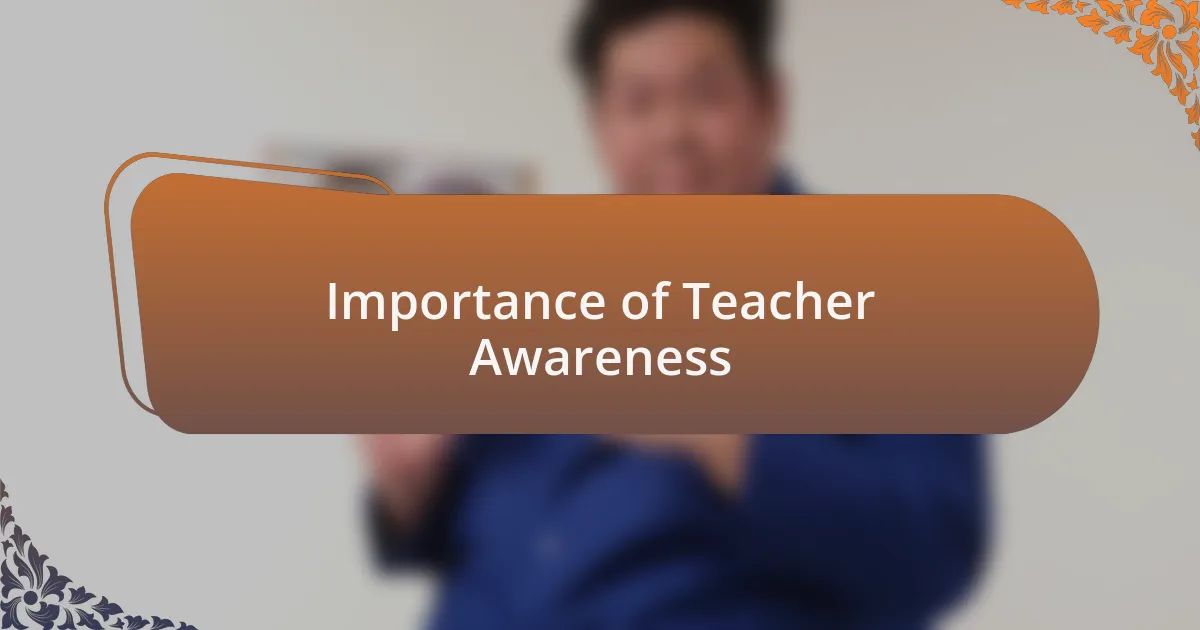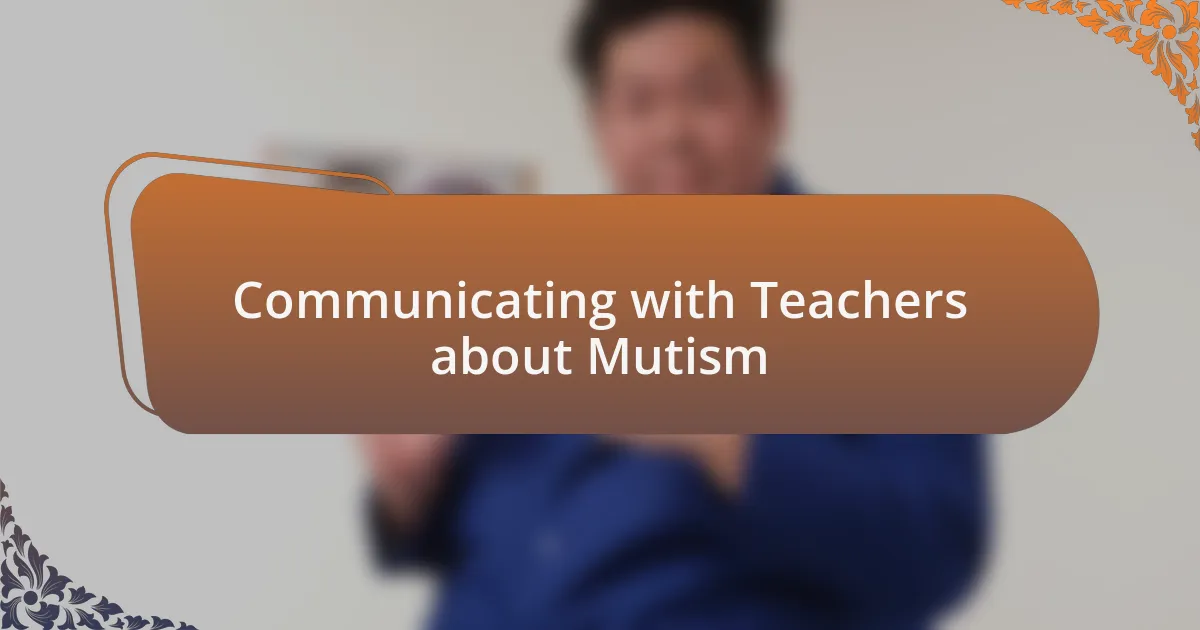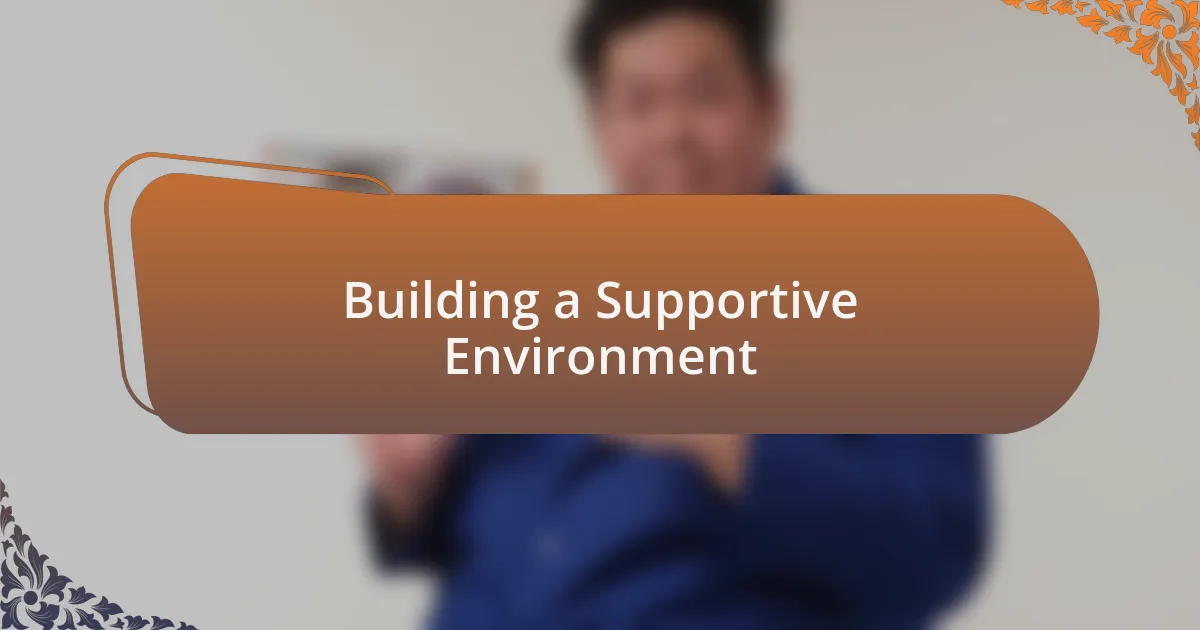Key takeaways:
- Selective Mutism is a complex anxiety disorder that requires compassionate support to help affected children express themselves in classroom settings.
- Teacher awareness and understanding are crucial in creating secure environments that foster participation and resilience among students with Selective Mutism.
- Implementing non-verbal communication methods, like whiteboards or drawings, and offering positive reinforcement can significantly enhance a child’s comfort and confidence.
- Building strong communication between parents and teachers can lead to tailored strategies that support the unique needs of children with Selective Mutism.

Understanding Selective Mutism
Selective Mutism is more than just a reluctance to speak; it’s a complex anxiety disorder that often manifests in specific settings, like school or social gatherings. I remember the first time I observed a child struggling to voice their thoughts in class while effortlessly chatting with friends outside of school. It made me wonder, how many brilliant voices are silenced by anxiety?
Understanding the nuances of Selective Mutism is crucial for both teachers and parents alike. I’ve seen how a patient approach can make a world of difference, providing these children with the safety they need to find their voice. Have you ever noticed how a simple, encouraging nod can light up a child’s face when they finally speak up? That moment is not just a breakthrough; it’s a testament to building trust.
It’s essential to remember that Selective Mutism isn’t a choice for the child; it’s a response to overwhelming anxiety. I once worked with a student who struggled deeply in a crowded classroom. Watching them slowly gain confidence was both heartwarming and eye-opening. How can we create environments that embrace these children and allow space for their voices to emerge without pressure? Such reflections are what fuel my commitment to fostering understanding in our educational settings.

Importance of Teacher Awareness
Teacher awareness is fundamental in helping children with Selective Mutism feel secure and understood. I recall a particular teacher who took the time to learn about one of her quiet students, patiently letting her respond when she felt comfortable. It was incredible to see that small investment in awareness transform that child’s experience in the classroom from isolation to a sense of belonging.
When educators are aware of Selective Mutism, it opens doors for effective strategies to support affected students. I remember a workshop where we discussed different techniques, like providing one-on-one check-ins or using non-verbal cues to encourage participation. These approaches can significantly reduce pressure on the child, which made me think: how many children could thrive if teachers were equipped with such insights?
Understanding Selective Mutism is not just beneficial for the child; it enriches the entire classroom environment. I once observed a teacher who fostered a supportive culture that encouraged all students to share in their own time. Seeing the way reluctant voices began to emerge reminded me how powerful awareness and support can be in unlocking potential — it’s not just about speech; it’s about cultivating confidence and community.

Common Signs of Selective Mutism
Recognizing the common signs of Selective Mutism is crucial for teachers. Many children may consistently struggle to speak in specific social settings, like at school, even if they communicate freely at home. I remember a child in my class who would sit silently, visibly anxious, while her peers chatted away. It was heartbreaking to witness her wanting to join in but unable to find her voice in those moments.
Another sign often overlooked is the physical response some children exhibit. For example, I once noticed a student who would fidget relentlessly or avoid eye contact when called upon. This behavior is more than just shyness; it often reflects deep-seated fear. It’s essential for educators to differentiate between a personality trait and a sign of Selective Mutism. Have you ever seen someone feel so trapped in silence that their body language spoke volumes? That was the case with my student, whose anxiety was palpable.
Lastly, many children with Selective Mutism may communicate through gestures or nods instead of words. I had a student who was brilliant yet chose to express herself with drawings rather than speaking. It struck me how vividly she conveyed her feelings and thoughts through art. This taught me that understanding these alternative forms of communication is vital. How many gems are we overlooking when we only prioritize verbal responses? Recognizing these signs helps create a more inclusive environment for all students.

Strategies for Teachers to Help
Creating a safe and supportive environment is essential for children with selective mutism. I remember a situation where I adjusted my classroom setup to provide cozy, quiet corners for students who needed a break from the social noise. I could see the relief on one child’s face as she curled up with a book, gathering her thoughts before rejoining her peers. Have you ever noticed how a little bit of space can spark confidence?
Engaging with these students in non-verbal ways can be incredibly effective. I once had a student who thrived when I encouraged him to use a whiteboard to communicate his ideas during group activities. This approach not only alleviated his anxiety but also allowed him to share his thoughts without the pressure of speaking aloud. Have you thought about how simple tools can bridge that gap?
Lastly, consistent positive reinforcement can work wonders in building a child’s comfort level. I remember offering small rewards for participation, like stickers or a few extra minutes of recess, and seeing a shy child light up when she finally spoke her first word in class. It made me reflect on the impact our encouragement can have. How often do we take the time to celebrate these small victories, recognizing the courage it takes for these kids to find their voice?

Personal Experience with Teachers
When I think back to my experiences with teachers who truly understood the challenges of selective mutism, one particular moment stands out. There was a teacher who noticed my anxiety during oral presentations. Instead of pushing me into the spotlight, she allowed me to share my thoughts in small, supportive groups. How empowering it felt to have my voice matter, even in a less pressured environment!
Another memory that resonates with me is when a teacher took the time to have one-on-one chats outside of class. I could see how much effort was put into making those moments comfortable—simple questions, a smile, and a patience that was palpable. Have you ever felt that sense of connection that makes it easier to open up?
In contrast, there were also experiences that were less supportive. I recall a teacher who insisted that every student must speak up in class, disregarding the unique needs of those struggling with selective mutism. The pressure to conform only magnified my discomfort. Isn’t it interesting how the approach of just one person can influence confidence—or undermine it completely?

Communicating with Teachers about Mutism
Communicating effectively with teachers about selective mutism can truly shape a student’s experience. I remember attending a parent-teacher meeting where my parents openly discussed my situation. The teacher responded with empathy and a willingness to adapt her teaching style, which increased my comfort in the classroom. Have you ever seen how a simple conversation can foster understanding and create a nurturing environment?
I once had a teacher who encouraged me to express my thoughts in writing when verbal communication felt too daunting. This approach ignited a spark within me. Being able to share my ideas on paper not only built my confidence but also opened up a dialogue with her. When have you found that alternative methods of communication made a difference for you or a loved one?
When it comes down to it, the key is openness and understanding. I learned that initiating discussions about needs can lead to better strategies being put in place by teachers. After all, what good is a classroom if a child feels they cannot participate?

Building a Supportive Environment
Creating a supportive environment for students with selective mutism is crucial. I remember a classroom where the teacher made it a point to foster a calm atmosphere, often incorporating soothing music and soft lighting. This thoughtful approach helped me feel more at ease, and I began to open up at my own pace. Have you ever noticed how a little change in ambiance can significantly impact one’s comfort level?
Another impactful moment for me came when my teacher organized small group activities designed to include everyone equally. She encouraged each student to contribute in their preferred way, whether through drawing, writing, or whispering their ideas out loud. I found solace in knowing that I was not pressured to speak up in a big crowd. Isn’t it fascinating how inclusivity can dissolve barriers?
It’s also important for teachers to be proactive in making connections. I recall a time when my teacher took the initiative to check in with me individually, asking how I preferred to communicate during class discussions. That simple gesture made me feel valued and understood. How often do we overlook the power of a personal touch in building trust with those who struggle?